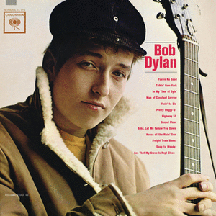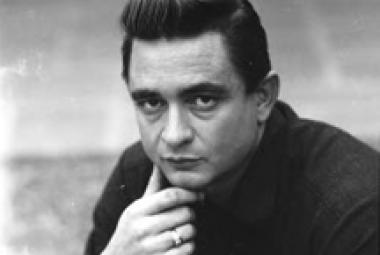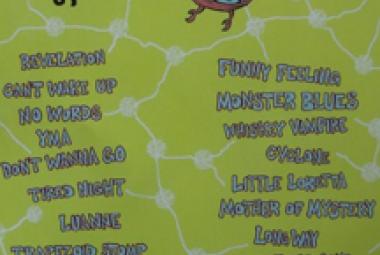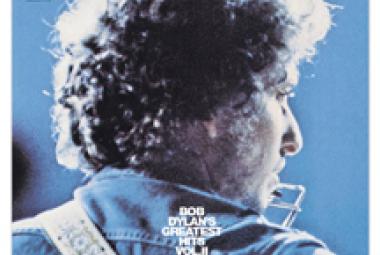Not all of the news is bad, however. Sometimes “what might have been” turns out to be more than anyone could ever have expected. The history behind the glorious hit single “The Sounds of Silence” (now identified as “The Sound of Silence”) by Simon and Garfunkel requires me, as usual, to make a big detour in the process, and to pick up the Bob Dylan story from earlier in this post.
* * *
It was clear that Bob Dylan’s second album would be very different from Bob Dylan, where only two original songs were presented. Wikipedia notes: “Many critics have noted the extraordinary development of Dylan’s songwriting immediately after completing his first album. Dylan biographer Clinton Heylin connects the sudden increase in lyrics written along topical and political lines to the fact that Dylan had moved into an apartment on West 4th Street with his girlfriend Suze Rotolo in January 1962. Rotolo’s family had strong left-wing political commitments; both of her parents were members of the American Communist Party. Dylan acknowledged her influence when he told an interviewer: ‘Suze was into this equality-freedom thing long before I was. I checked out the songs with her.’” That’s Suze Rotolo on Bob Dylan’s arm in the front cover shot of The Freewheelin’ Bob Dylan, walking down a snowy Greenwich Village street.
The recording sessions started in April 1962, and the album had a working title of Bob Dylan’s Blues – as late as July, this was still to be the name of the album. These April sessions included wonderful songs like “Sally Gal”, “Talkin’ John Birch Paranoid Blues”, “Rambling Gambling Willie”, “Talking Bear Mountain Picnic Massacre Blues”, “The Death of Emmett Till”, and “Let Me Die in My Footsteps”, among many others. Because Bob Dylan’s songwriting was progressing so quickly, nothing from the April 1962 sessions was utilized on the album as it was finally released (though a few were included on a brief early release of the album – copies are now worth five figures). I was, however, able to enjoy them on the many Dylan bootleg albums that I acquired over the years.
On February 7, 1962, at the Finjan Club in Montreal, Canada – according to a website called www.downtheroadtoecstasy.co.uk/ – Bob Dylan made what might be the first public performance of the standout track from The Freewheelin’ Bob Dylan, “Blowin’ in the Wind”. (Wikipedia mentions that Dylan “debuted” the song at Gerde’s Folk City on April 16, 1962, but that was apparently only the New York debut). I have a copy of this performance also on a Dylan bootleg, and it is chilling to hear Bob Dylan really working hard to present this now-legendary song to an audience that had never heard it before.
The introduction that Bob Dylan gives at the Montreal club makes it apparent that he knows what a new direction he was taking in his songwriting with “Blowin’ in the Wind”: “Here’s a song that’s in sort of in a set . . . a set pattern of songs that say, uh . . . [here, Dylan strums on his guitar for a while] that say a little more than, I love you and you love me, Let’s go over to the banks of Italy, and raise a happy family, You for me and me for . . . me.”
In a radio interview on New York radio station WBAI in June 1962 (which, if I am remembering this right, is included in part on Great White Wonder – or at least, one just like it is), legendary folksinger Pete Seeger described Bob Dylan as “the most prolific songwriter on the scene” and then asked Dylan about his songwriting; he replied in part: “I might go for two weeks without writing these songs. I write a lot of stuff. In fact, I wrote five songs last night [chuckling can be heard in the background], but I gave all the papers away in some place called the Bitter End” – one of the most famous music clubs in the City I might add.
* * *
As the months dragged on in the recording sessions for The Freewheelin’ Bob Dylan, producer John Hammond might have begun feeling a little out of his depth – no doubt he knew that he had the goods this time. He was also having power struggles with Albert Grossman, who became Bob Dylan’s manager on August 20, 1962. Additionally, Bob Dylan first started making recordings with a backing band in October 1962.
At any rate, another producer was brought in to help out – an unlikely though inspired choice as it turned out. As described in Wikipedia: “Because of [Albert] Grossman’s hostility to [John] Hammond, Columbia paired Dylan with a young, African-American jazz producer, Tom Wilson. Wilson recalled: ‘I didn’t even particularly like folk music. I’d been recording Sun Ra and [John] Coltrane. . . . I thought folk music was for the dumb guys. [Dylan] played like the dumb guys, but then these words came out. I was flabbergasted.’
“At a recording session on April 24, [1963,] produced by Wilson, Dylan recorded five new compositions: ‘Girl from the North Country’, ‘Masters of War’, ‘Talkin’ World War III Blues’, ‘Bob Dylan’s Dream’, and ‘Walls of Red Wing’. ‘Walls of Red Wing’ was ultimately rejected, but the other four were included in a revised album sequence.”
Besides the work on Freewheelin’, Tom Wilson wound up producing many of the albums that make up the heart of Bob Dylan’s early career: The Times They Are A-Changin’, Another Side of Bob Dylan, and Bringing it All Back Home.
* * *
Prior to beginning work on his next album, Highway 61 Revisited, Wikipedia reports: “In May 1965, Dylan returned from his tour of England feeling tired and dissatisfied with his material. He told journalist Nat Hentoff: ‘I was going to quit singing. I was very drained.’ The singer added, ‘It’s very tiring having other people tell you how much they dig you if you yourself don’t dig you.’
“As a consequence of his dissatisfaction, Dylan wrote 20 pages of verse he later described as a ‘long piece of vomit’. He reduced this to a song with four verses and a chorus – ‘Like a Rolling Stone’. He told Hentoff that writing and recording the song washed away his dissatisfaction, and restored his enthusiasm for creating music. Describing the experience to Robert Hilburn in 2004, nearly 40 years later, Dylan said: ‘It’s like a ghost is writing a song like that. . . . You don’t know what it means except the ghost picked me to write the song.’”
As it turned out, the early recording sessions that produced the classic “Like a Rolling Stone” recording were the only ones for Highway 61 Revisited that producer Tom Wilson worked on; Bob Johnston handled most of those duties, and he also went on to produce what many believe to be Bob Dylan’s magnum opus: Blonde on Blonde.















